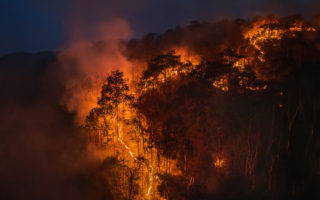
Bushfires in tropical forest release carbon dioxide (CO2) emissions and other greenhouse gases (GHG) that contribute to climate change.
Many of us have seen the results of wildfires raging in parts of the U.S. and Canada.
During a busy wildfire season, the smoke now ranges around the continent, impacting communities all over the country.
Part of remaining vigilant about this involves using the newest tools and the best ways to measure fires and their impact. That includes outdoor air quality. Then, you can figure out how the fires might ultimately affect your health. Not just your health. The health of your family, too.
Reporting on Fires and Air Pollution
For people living in a particular community, it can be hard to see what’s happening with forest fires. You might not know what the air quality is in any given community, at any given time.
However, government resources do give you the ability to really do a surprising amount of detailed research into what’s happening with the air quality where you are.
A federal resource called Airnow.gov provides a fire and smoke map that shows not only where wildfires are, but where the smoke is causing breathing problems for residents.
In the past few weeks, we’ve seen poor air quality in communities from coast to coast. One day everything will be fine. The next, you’re watching a haze roll in. Or you’re feeling like you’re trying to catch your breath on a daily run. Sometimes it’s hard to see the effect – but you feel it.
This is unfortunately becoming a more common experience for people who like to spend time outdoors. It’s something we should be knowledgeable about. In addition, a lot of the pollution gets into your indoor air, too, if you are using air conditioning. The AC system is pulling in the outside air, so that’s something to keep in mind.
A Snapshot in Time
At the current reading, as of press time, so to speak, the American landscape is mostly a mix of good and moderate air quality, while experts urge some of the more vulnerable residents to limit their outdoor activity when air is in the ‘moderate’ zone.
There are a few hot spots, such as one in Kansas, and a few to the south, that are labeled ‘unhealthy for sensitive groups.’
As for fires, the map currently shows more than a half-dozen of them raging inland in Washington. With the exception of a couple of wildfires on the coast near the Mexican border, most of them are further toward the country’s interior.
You can see where wildfire smoke contributes to those lower levels of air quality.
In Your Area
Users can also input a ZIP Code and get a rating for air quality, as of the current moment, and information on specific pollutants. To see air quality in your area, just go to Airnow.gov and use the provided text box to enter your five digit zip code.
This tool will also give you data on PM 2.5. PM 2.5 references a range of fine particles that can get in the lungs and cause health conditions.
These are particles of around 2.5 microns in diameter.
It’s important to look out for these pollutants, which are caused by vehicle emissions and industrial pollution, as well as natural wildfires.
Sensitive Groups
When it comes to those most sensitive to poor air quality, one of the most important groups of sensitive residents is children.
With relatively more vulnerable respiratory systems, they stand to receive the most impact from wildfire smoke and other pollutants.
There’s also important research showing that pregnant women should also stay out of the way of this kind of air pollution.
Other sensitive groups include the elderly, the immunocompromised, people with mold allergies, and others with secondary conditions that could be exacerbated by smoke or dirty air.
Protecting Your Home
There’s little that you can do about outdoor air quality, other than not going outside.
However, there’s a lot you can do to improve air quality inside your home, where you spend a lot of time, especially if the outdoor air is polluted.
This starts with using an air monitor to see amounts of pollution in a home’s indoor air, including:
· PM 2.5
· Mold
· Dust mite debris
· Pet dander
· VOCs
You can use a monitor like this one from uhoo to see what’s lurking in your air. Then you can remediate these problems using an air purifier machine.
Ask US Air Purifiers LLC about all of the design elements at play, and more around these modern machines that provide us with safety in our homes. As the impact of fires and other pollution sources grows, it becomes more important to put these kinds of solutions in place.